Chromosomal Basis of Inheritance | Botany - Answer the following questions | 12th Botany : Chapter 3 : Chromosomal Basis of Inheritance
Chapter: 12th Botany : Chapter 3 : Chromosomal Basis of Inheritance
Answer the following questions
Botany : Chromosomal Basis of Inheritance
Answer the following questions
13. When two different genes came from same parent they tend to remain together.
i) What is the name of this phenomenon?
ii) Draw the cross with suitable example.
iii) Write the observed phenotypic ratio.
Answer: (i) The phenomenon is called linkage.
(ii) William Bateson and Reginald C. Punnet crossed one
homozygous strain of sweet peas having purple
flowers and long pollen grains
with another homozygous strain having red
flowers and round pollen grains.
Results of Test Cross showed that a greater number of F2 plants had purple flowers and
long pollen or red flowers and round pollen. So they concluded that genes for
purple colour and long pollen grain and the genes for red colour and round
pollen grain were found close together in the same homologous pair of
chromosomes. This type of tendency of
genes to stay together during separation of chromosomes is called Linkage.
Alleles in coupling or cis configuration
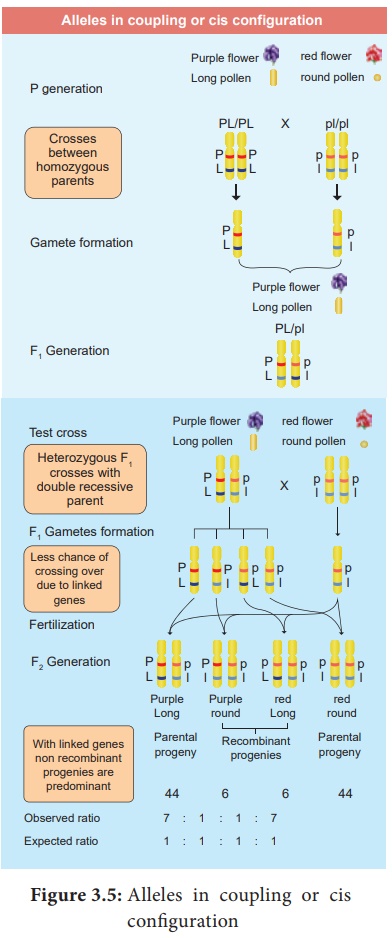
(iii) Phenotypic ratio 7 : 1 : 1 : 7
14. If you cross dominant genotype PV/PV male Drosophila with double recessive female and obtain F1 hybrid. Now you cross F1 male with double recessive female.
i) What type of linkage is seen?
ii) Draw the cross with correct genotype.
iii) What is the possible genotype in F2 generation?
Answer: (i) Complete linkage
(The tendency of genes
to stay together during separation of chromosomes)
(ii)
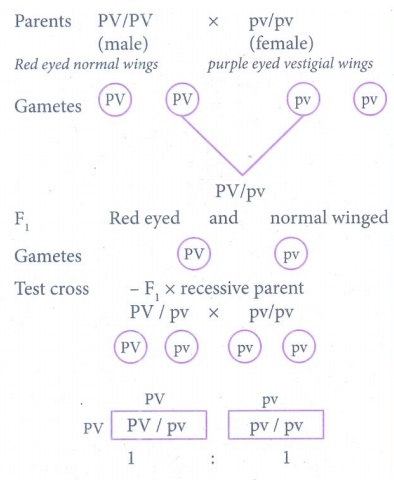
(iii) PV/pv and pv/pv in the ratio 1:1.
15.

i) What is the name of this test cross?
ii) How will you construct gene mapping from the above given data?
iii) Find out the correct order of genes.
Answer: (i) Three point test cross - gene mapping.
(ii)

Recombinant frequency
between A and B:
RF = [ Total no. of
recombinants / Total no. of progenies ] x 100
= (239 / 1200) x 100 =
19.9 %
Recombinant frequency
between A and C
RF = (482 / 1200) x 100
= 40.1%
Recombinant frequency
between B and C
RF = (261 / 1200) x
100 = 21.7%
RF is higher between A
and C, so they must be farthest apart. The locus B must lie between them.
Gene mapping:

(iii) ABC / abc
16. What is the difference between missense and nonsense mutation?
Answer: The mutation where the codon for one amino acid is changed
into a codon for another amino acid is called Missense or non-synonymous mutations. The mutations where codon for
one amino acid is changed into a termination or stop codon is called Nonsense mutation.
17. 
From the above figure identify the type of mutation and explain it.
Answer: The figure shows structural chemical aberration-
Duplication-Reverse tandem type.
Reverse tandem duplication:
The duplicated segment
is located immediately after the normal segment but the gene sequence order
will be reversed.
18. Write the salient features of Sutton and Boveri concept.
Answer: Sutton and Boveri (1903) independently proposed the
chromosome theory of inheritance. Sutton united the knowledge of chromosomal
segregation with Mendelian principles and called it chromosomal theory of
inheritance.
Salient features of the Chromosomal theory of inheritance:
Answer: (i) Somatic
cells of organisms are derived from the zygote by repeated cell division
(mitosis). These consist of two identical sets of chromosomes. One set is
received from female parent (maternal) and the other from male parent
(paternal). These two chromosomes constitute the homologous pair.
(ii) Chromosomes retain their structural uniqueness and
individuality throughout the life cycle of an organism.
(iii) Each chromosome carries specific determiners or Mendelian
factors which are now termed as genes.
(iv) The behaviour of chromosomes during the gamete formation
(meiosis) provides evidence to the fact that genes or factors are located on
chromosomes.
19. Explain the mechanism of crossing over.
Answer: Mechanism of Crossing Over
Crossing over is a
precise process that includes stages like synapsis, tetrad formation, cross
over and terminalization.
(i) Synapsis:
Intimate pairing
between two homologous chromosomes is initiated during zygotene stage of
prophase I of meiosis I. Homologous chromosomes are aligned side by side
resulting in a pair of homologous
chromosomes called bivalents. This pairing phenomenon is called synapsis or syndesis. It is of three types,
1. Procentric synapsis: Pairing starts from middle of the chromosome.
2. Proterminal synapsis: Pairing starts from the telomeres.
3. Random synapsis: Pairing may start from anywhere.
(ii) Tetrad Formation:
Each homologous
chromosome of a bivalent begin to form two identical sister chromatids, which
remain held together by a centromere. At this stage each bivalent has four
chromatids. This stage is called tetrad
stage.
(iii) Cross Over:
After tetrad
formation, crossing over occurs in pachytene stage. The non-sister chromatids
of homologous pair make a contact at one or more points. These points of
contact between non-sister chromatids of homologous chromosomes are called Chiasmata (singular-Chiasma). At
chiasma, cross-shaped or X-shaped structures are formed, where breaking and
rejoining of two chromatids occur. This results in reciprocal exchange of equal
and corresponding segments between them. Synapsis and chiasma formation are
facilitated by a highly organised structure of filaments called Synaptonemal Complex (SC). This
synaptonemal complex formation is absent in some species of male Drosophila.
Hence crossing over does not takes place.
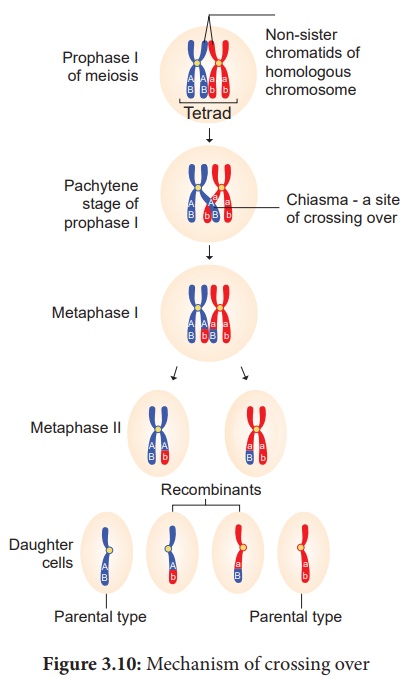
20. Write the steps involved in molecular mechanism of DNA recombination with diagram.
Answer:
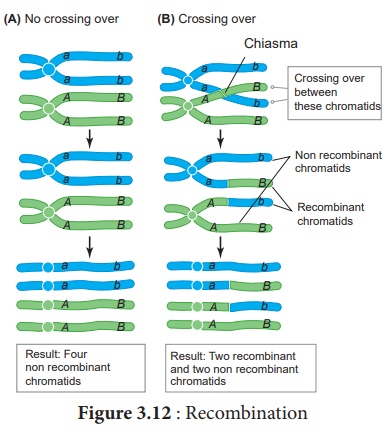
The widely accepted
model of DNA recombination during crossing over is Holliday’s hybrid DNA model.
It was first proposed by Robin Holliday in 1964. It involves several steps. ( Figure
)
(i) Homologous DNA molecules are paired side by side with
their duplicated copies of DNAs.
(ii) One strand of both DNAs cut in one place by the enzyme
endonuclease.
(iii) The cut strands cross and join the homologous strands forming the Holliday
strcture or Holliday junction.
(iv) The Holliday junction migrates away from the original
site, a process called branch migration, as a result heteroduplex region is
formed.
(v) DNA strands may cut along through the vertical (V) line or
horizontal (H) line.
(vi) The vertical cut will result in heteroduplexes with
recombinants.
(vii) The horizontal cut will result in heteroduplex with non
recombinants.
21. How is Nicotiana exhibit self-incompatibility. Explain its mechanism.
Answer: (i) In plants, multiple alleles have been reported in
association with self-sterility or self-incompatibility. Self - sterility means
that the pollen from a plant is unable to germinate on its own stigma and will
not be able to bring about fertilization in the ovules of the same plant.

The
self-incompatibility in relation to its genotype in tobacco
(ii) East (1925) observed multiple alleles in Nicotiana which are responsible for
self-incompatibility or self-sterility. The gene for self-incompatibility can
be designated as S, which has allelic series S1, S2, S3,
S4 and S5 .
(iii) The cross-fertilizing tobacco plants were not always
homozygous as S1S1 or S2S2, but all
plants were heterozygous as S1S2, S3S4,
S5S6.
(iv) When crosses were made between different S1S2 plants, the pollen tube did not develop
normally. But effective pollen tube development was observed when crossing was
made with other than S1S2 for example S3S4.
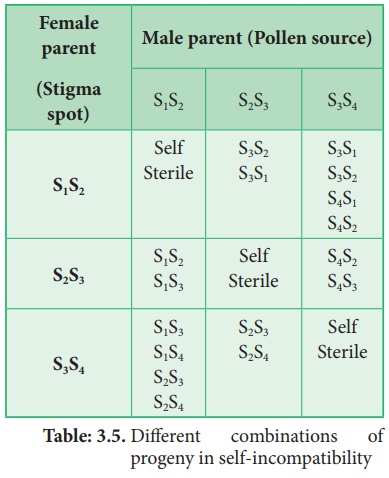
Different combinations
of progeny in self-incompatibility
22. How sex is determined in monoecious plants. write their genes involved in it.
Answer: (i) Zea mays (maize) is an example for monoecious, which means
male and female flowers are present on the same plant.
(ii) There are two types of inflorescence. The terminal
inflorescence which bears staminate florets develops from shoot apical meristem
called tassel. The lateral inflorescence
which develop pistillate florets develops from axillary bud and is called ear or cob.
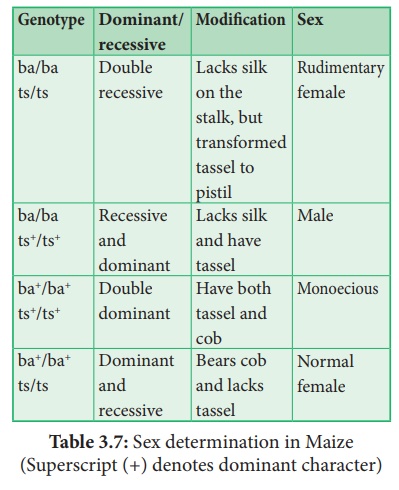
Sex determination in Maize (Superscript (+) denotes
dominant character)
(iii) Unisexuality in maize occurs through the selective abortion
of stamens in ear florets and pistils in tassel florets.
(iv) A substitution of two single gene pairs 'ba' for barren plant and 'ts' for tassel seed makes the difference between monoecious and dioecious (rare) maize plants. The allele for barren plant (ba) when homozygous makes the stalk staminate by eliminating silk and ears. The allele for tassel seed (ts) transforms tassel into a pistillate structure that produce no pollen. Most of these mutations are shown to be defects in gibberellin biosynthesis. Gibberellins play an important role in the suppression of stamens in florets on the ears.
23. What is gene mapping? Write its uses.
Answer: The diagrammatic representation of position of genes and
related distances between the adjacent genes is called genetic mapping. It is directly proportional to the frequency of
recombination between them. It is also called as linkage map. The concept of gene mapping was first developed Alfred H Sturtevant.
Uses of genetic mapping:
(i) It is used to determine gene order, identify the locus of
a gene and calculate the distances between genes.
(ii) They are useful in predicting results of dihybrid and
trihybrid crosses.
(iii) It allows the geneticists to understand the overall
genetic complexity of particular organism.
24. Draw the diagram of different types of aneuploidy.
Answer: It is a condition in which diploid number is altered
either by addition or deletion of one or more chromosomes. Different types of
Aneuploidy is show below. It is classified into two main types - Hyperploidy
and Hypoploidy.
Ploidy
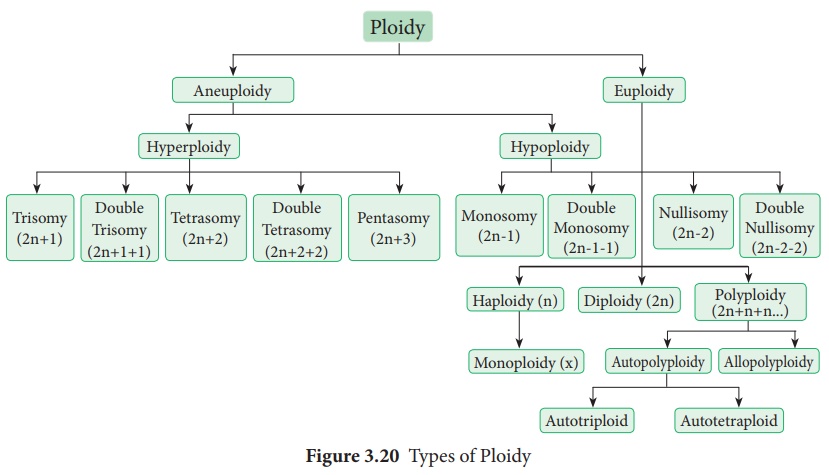
Types of Aneuploidy
25. Mention the name of man-made cereal. How it is formed?
Answer: Triticale is the successful first man made cereal.
Depending on the ploidy level Triticale can be divided into three main groups.
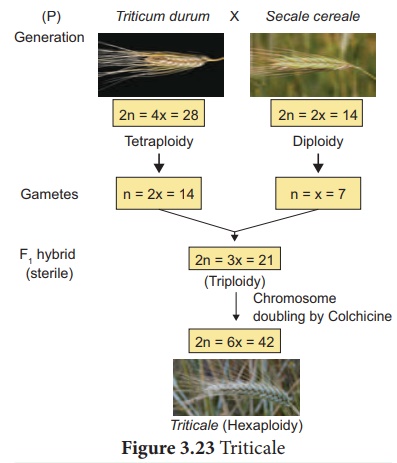
(i) Tetraploidy: Crosses between
diploid wheat and rye.
(ii) Hexaploidy: Crosses between tetraploid wheat Triticum durum (macaroni
wheat) and rye
(iii) Octoploidy: Crosses between hexaploid wheat T. aestivum (bread wheat) and rye.
Hexaploidy: Triticale hybrid plants demonstrate characteristics of
both macaroni wheat and rye. For example, they combine the high-protein content
of wheat with rye’s high content of the amino acid lysine, which is low in
wheat.
Colchicine, an alkaloid when applied in low concentration to the
growing tips of the plants induce polyploidy.
Related Topics